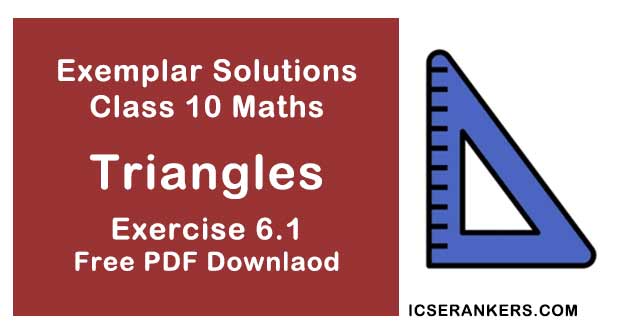Chapter 6 Triangles NCERT Exemplar Solutions Exercise 6.1 Class 10 Maths

Chapter Name | NCERT Maths Exemplar Solutions for Chapter 6 Triangles Exercise 6.1 |
Book Name | NCERT Exemplar for Class 10 Maths |
Other Exercises |
|
Related Study | NCERT Solutions for Class 10 Maths |
Exercise 6.1 Solutions
Multiple Choice Questions
Choose the correct answer from the given four options:
1. In figure, if ∠BAC = 90° and AD ⊥ BC . Then,
If the lengths of the diagonals of rhombus are 16 cm and 12 cm. Then, the length of the sides of the rhombus is
(A) BD.CD = BC2
(B) AB.AC = BC2
(C) BD.CD = AD2
(D) AB.AC = AD2
Solution
(C) BD.CD = AD2
In ∆ADB and ∆ADC,
We have,
∠D = ∠D = 90° (∵ AD ⊥ BC)
∠DBA = ∠DAC [each angle = 90°- ∠C]
From AAA similarity rule,
∆ADB ∼ ∆ADC
Therefore,
BD/AD = AD/CD
⇒ BD.CD = AD2
2. If the lengths of the diagonals of rhombus are 16 cm and 12 cm. Then, the length of the sides of the rhombus is
(A) 9 cm
(B) 10 cm
(C) 8 cm
(D) 20 cm
Solution
(B) 10 cm
We have,
A rhombus is a simple quadrilateral whose four sides are of same length and diagonals are perpendicular bisector of each other.
Now,
AC = 16cm and
BD = 12 cm
∠AOB = 90°
AC and BD bisects each other
AO = 1/2 AC
BO = 1/2 BD
So,
AO = 8cm
BO = 6cm
In right angled ∆AOB,
By Pythagoras theorem,
We have,
AB2 = AO2 + OB2
⇒ AB2 = 82 + 62
= 64 36 = 100
⇒ AB = √100 = 10 cm
As the four sides of a rhombus are equal.
So, one side of rhombus = 10 cm.
3. If ∆ABC ∼ ∆EDF and ∆ABC is not similar to ∆DEF, then which of the following is not true ?
(A) BC.EF = AC.FD
(B) AB.EF = AC.DE
(C) BC.DE = AB.EF
(D) BC.DE = AB.FD
Solution
(C) BC.DE = AB.EF
If sides of one triangle are proportional to the side of the other triangle, and the corresponding angles are also equal, then the triangles are similar by SSS similarity.
So, ∆ABC ∼ ∆EDF
By similarity rule,
AB/ED = BC/DF = AC/EF
At first we take,
AB/ED = BC/DF
⇒ AB.DF = ED.BC
Hence, option (D) BC · DE = AB.FD is true
Now taking,
BC/DF = AC/EF , we get
⇒ BC.EF = AC.DF
Hence, option (A) BC.EF = AC.FD is true
Now if,
AB/ED = AC/EF, we get ,
⇒ AB.EF = ED.AC
Hence, option (B) AB.EF = AC.DE is true.
(A) ∆PQR ~ ∆CAB
(B) ∆PQR ~ ∆ABC
(C) ∆CBA ~ ∆PQR
(D) ∆BCA ~∆PQR
AB/QR = BC/PR = CA/PQ
∆PQR ~ ∆CAB

(A) 50°
(B) 30°
(C) 60°
(D) 100°
In ∆APB and ∆CPD,
∠APB = ∠CPD = 50° (vertically opposite angles)
AP/PD = 6/5 ...(i)
And,
BP/CP = 3/2.5
⇒ BP/CP = 6/5 ...(ii)
From equations (i) and (ii),
AP/PD = BP/CP
Therefore,
∆APB ~∆DPC [using SAS similarity rule]
From ∆APB,
(B) DE/PQ = EF/RP
(C) DE/QR = DF/PQ
(D) EF/RP = DE/QR
We have,

In ∆DEF and ∆PQR,
∠D = ∠Q,
∠R = ∠E
∆DEF ~ ∆QRP
∠F = ∠P
DF/QP = ED/RQ = FE/PR
(A) Congruent but not similar
In ∆ABC and ∆DEF,

(A) 9
(B) 3
(C) 1/3
(D) 1/9
We have,
∆ABC ~ ∆PQR
BC/QR = 1/3
We know that, the ratio of the areas of two similar triangles is equal to square of the ratio of their corresponding sides.
ar(PRQ)/ar(BCA) = QR2/BC2
QR2 /BC2 = 32 /12 = 9
(A) DE = 12 cm, ∠F = 50°
(B) DE = 12 cm, ∠F = 100°
(C) EF = 12 cm, ∠D = 100°
(D) EF = 12 cm, ∠D = 30°

∠B = ∠F
180° - (50° + 30°)
= 100°
Now,
AB/DF = AC/DE
⇒ 5/7.5 = 8/DE
⇒ DE = 12 cm
(A) ∠B = ∠E
(B) ∠A = ∠D
(C) ∠B = ∠D
(D) ∠A = ∠F

Given, in ∆ABC and ∆EDF,
AB/DE = BC/FD
Therefore,
∆ABC ~ ∆EDF if, ∠B = ∠D [By SAS similarity criterion]
(A) 10 cm
(B) 12 cm
(C) 20/3 cm
(D) 8 cm


(A) PR . QR = RS2
(B) QS2 + RS2 = QR2
(C) PR2 + QR2 = PQ2
(D) PS2 + RS2 = PR2




